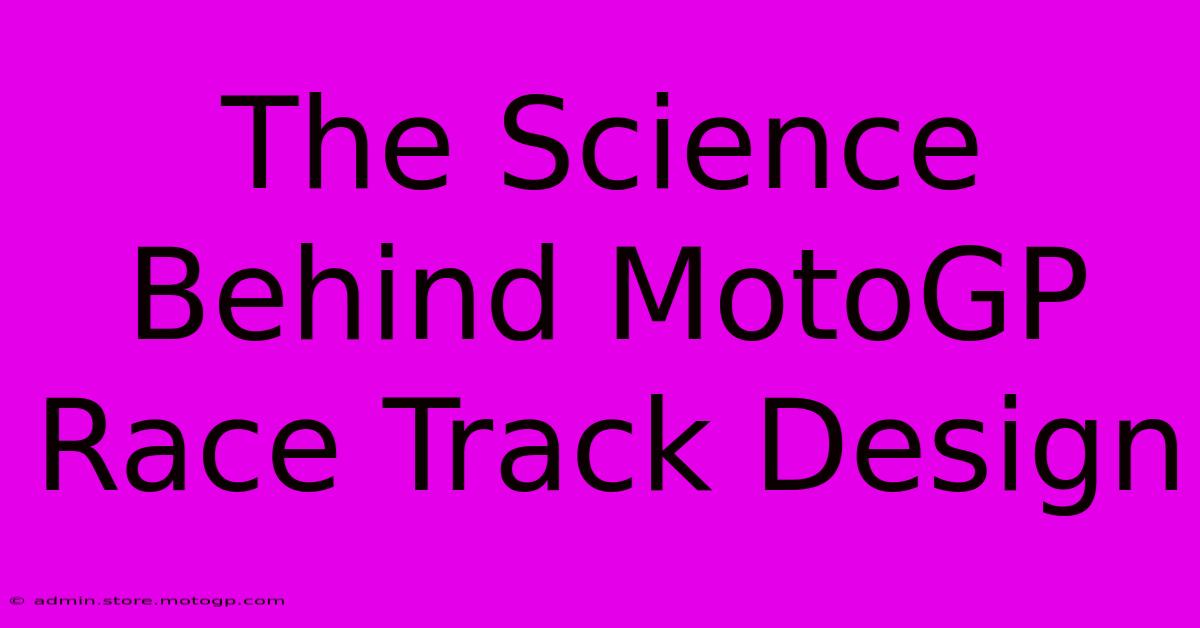The Science Behind MotoGP Race Track Design

Table of Contents
The Science Behind MotoGP Race Track Design
MotoGP, the pinnacle of motorcycle racing, wouldn't be the thrilling spectacle it is without its meticulously designed race tracks. These aren't just asphalt ribbons; they're complex engineering marvels, a blend of science, art, and a dash of thrilling danger. Understanding the science behind their design reveals a fascinating interplay of physics, rider psychology, and spectator experience.
The Physics of Speed and Safety
At the heart of MotoGP track design lies the physics of motion. Every curve, straight, and elevation change is calculated to optimize speed while ensuring rider safety.
Understanding Cornering Forces:
- Centripetal Force: This force, directed towards the center of a curve, keeps bikes from flying off the track. Track designers use banking (superelevation) and the radius of the curve to manage this force, allowing riders to maintain higher speeds through corners. Steeper banking allows for faster cornering speeds.
- Friction: The grip between tires and tarmac is crucial. The surface material, its texture, and the amount of grip available directly influence a rider's ability to lean into corners and accelerate out of them. Track designers carefully consider the surface composition for optimal grip in varying weather conditions.
- Aerodynamics: Modern MotoGP bikes generate significant downforce, improving stability at high speeds. Track design incorporates straights long enough to allow bikes to reach their top speeds and utilize this downforce effectively. Conversely, tight chicanes and slow corners force riders to manage aerodynamic forces more carefully.
Optimizing Track Flow:
A well-designed track promotes a smooth flow, minimizing abrupt changes in speed and direction. This improves racing action by preventing bunching and creating more overtaking opportunities. Design elements contributing to optimal flow include:
- Rhythm and Variation: Tracks aren't simply a series of identical corners. A good design provides a mix of fast and slow corners, long straights, and challenging chicanes, maintaining rider engagement and preventing predictability.
- Elevation Changes: Undulating terrain can enhance the racing experience. Rolling hills and elevation changes add another layer of complexity, demanding precise bike control and rewarding skilled riders. This also contributes to exciting viewing angles for spectators.
- Run-off Areas: Safety is paramount. Generous run-off areas, using gravel traps or tarmac run-offs, are essential for mitigating the consequences of crashes. The design and placement of these areas are carefully considered to reduce the severity of impacts.
The Psychology of Track Design
Beyond the physics, track design also considers the psychological aspects of racing.
Creating Overtaking Opportunities:
Tracks aren't just about speed; they're about competition. Clever track design can create overtaking opportunities, increasing the excitement and drama of the race. This often involves:
- Strategic Corner Placement: Placing corners that allow for multiple racing lines and different braking points can create opportunities for drivers to overtake.
- Long Straights: These provide ample opportunities for riders to gain speed and initiate overtaking maneuvers.
- Chicane Placement: Strategically placed chicanes can break up the racing line, allowing trailing riders to get closer to those in front.
Rider Engagement and Challenge:
A challenging track keeps riders engaged and pushes their skills to the limit. This is achieved through:
- Complex Corner Combinations: Series of connected corners demand precise control and line selection.
- Blind Corners: Corners with limited visibility add an element of risk and reward, testing a rider's bravery and judgment.
The Spectator Experience: A Key Consideration
The design of a MotoGP track isn't solely for the riders; it's also about providing a fantastic viewing experience for spectators.
- Grandstands and Viewing Areas: The placement of grandstands and viewing areas is carefully planned to offer spectators the best possible view of the action.
- Accessibility: The track design should provide easy access for spectators, allowing them to move around the circuit and enjoy different vantage points.
Conclusion: A Symphony of Science and Skill
MotoGP track design is a fascinating blend of physics, psychology, and engineering. The successful tracks, like the legendary Circuit de Barcelona-Catalunya or the challenging Red Bull Ring, are testaments to the art of creating a thrilling and safe environment for both riders and spectators. Every curve, straight, and elevation change is a carefully considered element in a complex symphony of science and skill, culminating in the spectacular races we witness.

Thank you for visiting our website wich cover about The Science Behind MotoGP Race Track Design. We hope the information provided has been useful to you. Feel free to contact us if you have any questions or need further assistance. See you next time and dont miss to bookmark.
Featured Posts
-
Discover The Heart And Soul Of America The Queen Circuit
Feb 17, 2025
-
Motorcycle Track Days At Cota A Riders Paradise
Feb 17, 2025
-
Unlock Exclusive Benefits Cota Hospitality
Feb 17, 2025
-
Experience The Roar Austin Gp Sprint Race Atmosphere
Feb 17, 2025
-
Moto Gp Images From Grid To Glory
Feb 17, 2025
